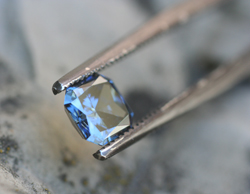Richard Poncher can continue to rest in peace, at least for a little while — his widow Elsie’s recent attempt to sell the crypt where he’s been residing for the last 23 years suffered an untimely demise. Located precisely above the eternal filing cabinet in which the bones of Marilyn Monroe slumber, in a tiny cemetery in downtown Los Angeles, Mr. Poncher’s crypt attracted worldwide publicity and a high bid of $4.6 million when his wife put it up for sale on eBay several weeks ago. The bidder reneged after the auction ended, however, and the search for a buyer continues.
Had the bidder acted in good faith, the crypt would have gone for roughly $328,000 per square foot, making it the most expensive real estate in the history of the world. A legitimate buyer is unlikely to match that offer, but even if someone only forks over half as much, the question remains: Why? Sure, you’ll have a nice way to one-up boastful barroom strangers for as long as you continue to draw breath, but for that kind of money, there must be more impressive ways to memorialize yourself. A couple million dollars can buy an awful lot of granite.
Of course, that’s an old-fashioned way of thinking. Our ancestors marked their place in this world with solid blocks of stone. They longed for reverence and respect, and aimed to show the universe that the mere passage of time could not erase their impact on the place in which they lived. But while cemeteries are great for establishing a mood of gravitas and permanence, they’re also impersonal and homogenizing. In a cemetery, we might be able to tell if a man was rich or poor by the size of his monument, but how much more can we say of him?
Every once in a while, a spark of humanity leaps forth in the form of a sad or witty epitaph, and over the last couple decades, the funeral industry has worked hard to make death more lively and more personalizable. We’ve got caskets that look like beer cans now, headstones shaped like teddy, an internment area in a Chicago cemetery that is modeled after Wrigley Field’s centerfield wall. But despite such efforts, cemeteries are still remote, at a remove from the hustle and bustle of life by design, the places where we ghettoize the dead.
For our forebears, they worked. For anyone whose worst hell is no Wi-Fi, they’re worse than Satan’s secret basement torture chamber. Even in death, we want to stay connected, relevant, in the mix. This, no doubt, is why the right to hover a few inches above Marilyn Monroe’s sexy sternum and fibulas until the end of time is so attractive to some folks. Being haunted for eternity by the sad, creepy obsessives who continue to worship a dead movie star decades after her death may not sound exactly like paradise, but at least you get visitors.
For anyone who wants to stay truly accessible after death, however, cremation is a much more sensible choice. And no doubt that’s why its popularity is increasing so much these days. People say they choose it because it’s cheaper, it’s simpler, it’s eco-friendly, but surely those aren’t the only reasons. Cremation makes you portable, subdividable, and impossible to consign so easily to a rote once-a-year visit.
Granted, being turned into kitty litter and dumped in a glorified spittoon doesn’t sound all that glamorous. But that’s old cremation technology, the equivalent of a cell phone from 1983. Today, thanks to a company called LifeGem, even the frumpiest corpse is a literal diamond in the rough. Using technology originally developed by General Electric, LifeGem turns the carbon from cremated ashes into radiant, multi-faceted jewels that are “molecularly identical to naturally occurring diamonds.”
Depending on size and color, LifeGem diamonds range in price from $2,699 to $24,999. For the cost of a traditional funeral, those who wants to stay in circulation forever can transform themselves into cufflinks, pendants, earrings — all of which, instead of exiling to the dusty closet in the unused bedroom, heirs, loved ones, and even strangers would gladly keep close to their hearts. For the cost of a $4.6 million crypt, you could turn yourself into a pile of a bling so large even Lil Wayne couldn’t wear it all at once. Hire the right jewelry designer to fashion your remains into a stunning necklace, and even the ghost of Marilyn Monroe might want to jump your bones. She did have a thing for diamonds, after all. • 25 September 2009




